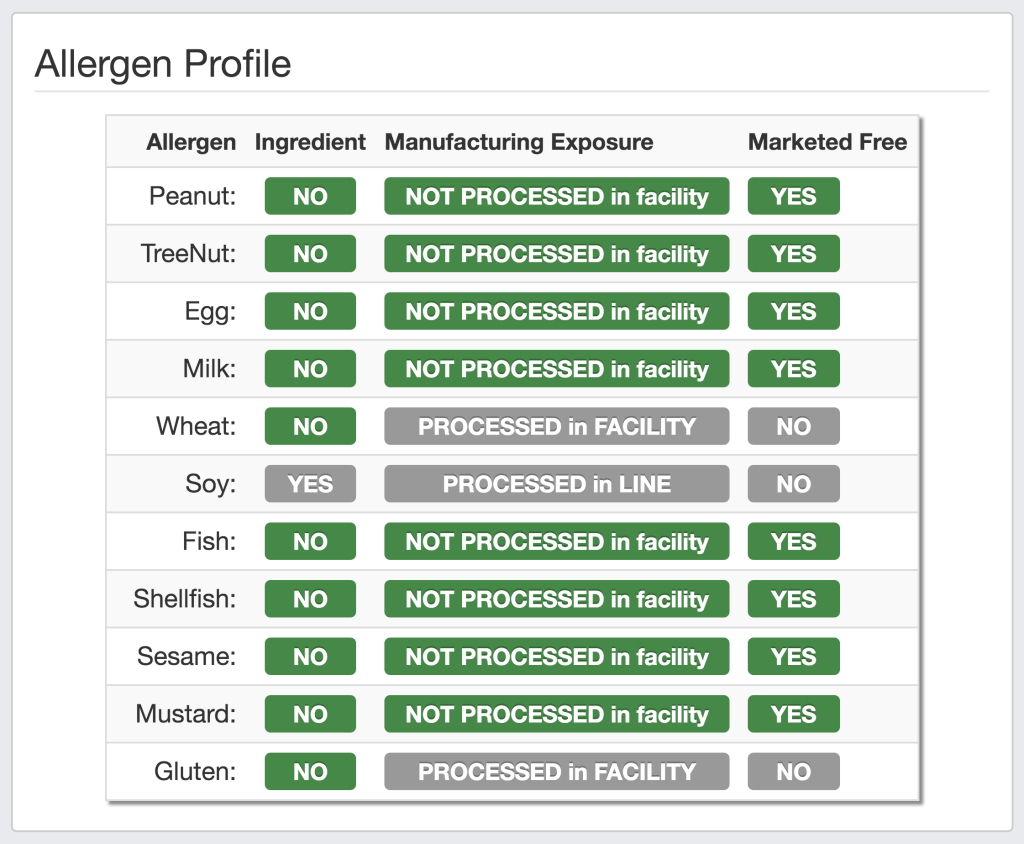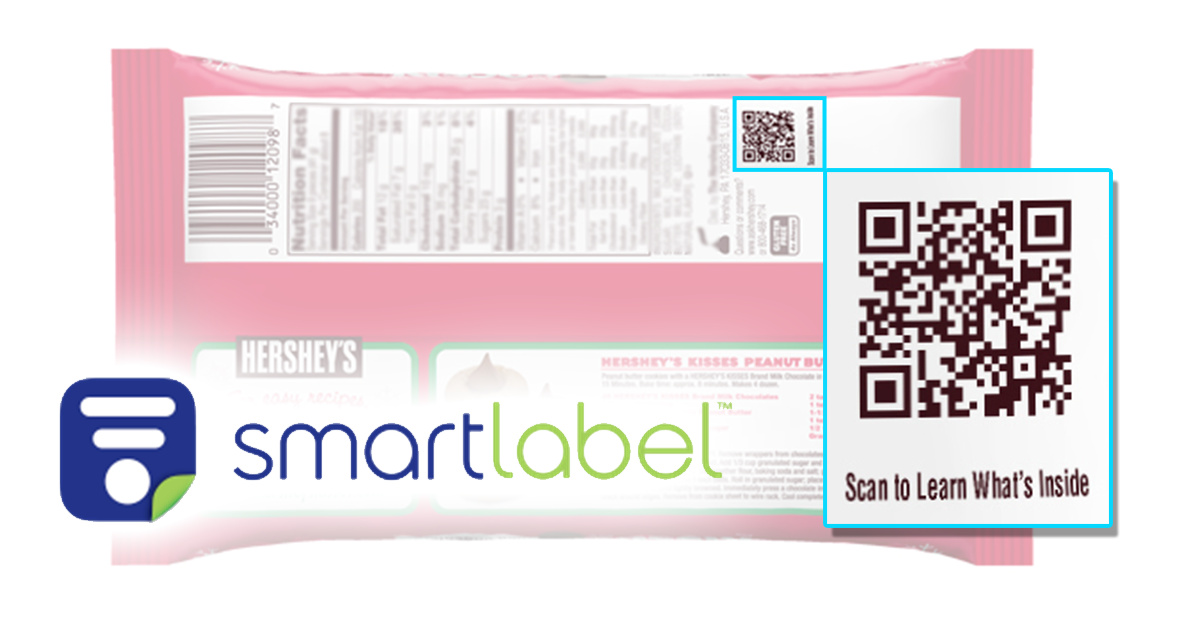This past December (2015), the Grocery Manufacturers Association [Now the Consumer Brands Association] announced a new labeling initiative piloted by the Hershey Company dubbed SmartLabel™. The GMA promises: “SmartLabel will provide consumers at the touch of finger all the information they want to know about what they are purchasing.” We at SnackSafely.com respectfully disagree.
Before we jump into the finer points of SmartLabel, understand that the GMA is the largest trade organization that represents the largest food, beverage, and consumer products companies in the world. It is funded by these companies to represent and progress their mutual interests, not the interests of consumers except where they intersect with those of the sponsors.

Armed with this information, the idea behind SmartLabel is quite simple: provide a unique QR code displayed on the label of each product that — when scanned with a special smartphone app — displays information about the product including the ingredient list, certifications, nutritional data, et al in a standardized format that is common across all products.
Here is Hershey’s video describing the initiative:
The promise of SmartLabel is admirable: Once fully implemented, no longer will you have to navigate each company’s website or call the company’s help line to acquire the consumer information you need; instead, you’ll simply scan the product code and be presented with all the information on a single page.
Though admirable, the reality is that SmartLabel can’t deliver on its promise.
The problem with SmartLabel is not the concept itself but the implementation, which, disguised as a consumer app, actually caters to manufacturers by helping them reduce the number of calls to their consumer lines while building a valuable database that can be marketed to derive additional streams of revenue.
But dig a little deeper into the SmartLabel Fact Sheet and you’ll find the following disclaimer disguised as a feature:
The first version of SmartLabel™, known as Gen. 1.0, will include over 350 product attributes. Each attribute is classified as either “required” or “voluntary.” All “required” attributes in Gen. 1.0 are defined by US regulations and required to be available to consumers by U.S. law. A company can decide whether to disclose “voluntary” product attributes; and if it does so, it must use an industry-recognized standard definition. All information on a SmartLabel™ landing page is bound by the same accuracy requirements as if it were printed on a label.
Note that companies that opt to participate in the initiative need only provide the information already required on the label. The initiative does nothing to mandate more complete disclosure of allergens or the potential for allergen cross-contact than FDA regulations already require.
To understand the conundrum for consumers whose lives depend on correct, comprehensive allergen information, note that FALCPA regulations mandate that the presence of the Top-8 allergens need only be disclosed when they are ingredients of the product, not when they may contaminate the product as a result of shared lines or facilities. Common advisory warnings like “Manufactured on equipment that also processes peanuts” are entirely voluntary and may be (and often are) omitted by manufacturers. Other common allergens including sesame and mustard can be hidden in the ingredient list as “natural spices” or “flavorings”, thus posing an additional threat to people allergic to these foods.
Conceptually, a SmartLabel page would not even be required to provide the voluntary statements companies choose to list on the label, much less disclose those allergens that are hidden from the ingredient list or might be introduced via cross-contact.
We believe SmartLabel may actually present a danger to consumers with food allergies by providing a false sense of security: Those that rely on the service may believe the disclosures provided in the Allergen section are required to be comprehensive and thus provide all the information they need to know to stay safe, when in fact there is no such requirement.
We urge the GMA to reconsider the initiative by adopting rules for more complete disclosure and mandating such rules be followed for manufacturers to participate. As a template for crafting such a process, we offer the GMA the option to license the platform and policies developed at SnackSafely.com free of charge.
Manufacturers join the SnackSafely.com Manufacturer Partnership — comprised of Tootsie Roll Industries and 50+ [now 130+ other companies] — only by accepting our terms of service and agreeing to abide by our rules regarding the mandatory disclosure of allergens. Each manufacturer then utilizes our platform to disclose precisely how 11 allergens are processed during the manufacture of each product, including whether the allergen is processed in the manufacturing line or facility.
As an example of how that information might be conveyed to the user, consider the Allergen Profile provided by our Allergence product screening service. Each profile provides critical allergen information in a straight-forward, unambiguous manner so the consumer can be confident of the information provided and follow up to verify the manufacturer’s claims.

We hereby extend an offer to the GMA to leverage our expertise in the interest of better serving the needs of the allergic community, estimated to number 15 million Americans, almost 6 million of which are children.
We urge Hershey’s and the GMA member manufacturers to reconsider the policies that currently underpin SmartLabel and address the ambiguities that will otherwise be perpetuated and exacerbated by the initiative. Without such an effort, SmartLabel will be rendered as yet another app that purports to help the allergic community while having the potential to do more harm than good.
Now is the time to rethink SmartLabel while the initiative is still in its infancy. To fulfill its promise, the GMA needs to focus on the needs of all consumers, not just those of the manufacturers.
- New SmartLabel™ Initiative Gives Consumers Easy Access to Detailed Ingredient Information on Thousands of Products — Company Press Release
- SmartLabel™ Fact Sheet — SmartLabel Website
- Facts and Statistics — Food Allergy Research and Education







Not everyone has a smartphone and the info needs to be simple and easy to access and read, whether one is 4 years old or 94 years old. The info we need ought to be on the label. You are absolutely right that apps are data collectors for the purposes of marketing. This idea is just smoke and mirrors, the facts need to be on the package. Thanks, Dave!
Totally agree with Sharon and you guys. I don’t see the value in this service, only the harm. Just put the info on the label, and actually label for shared lines and facilities. THAT’S what would be helpful.
I’ve been watching this effort develop for the past several years. It came about because the food manufacturers were unhappy with third party applications providing incomplete, inaccurate, or old data about their products. They wanted a “trusted source of data” so that consumers could make decisions based on the true facts about their products. It is mostly about trust and transparency but does provide a marketing angle too. I think it is a good idea because I could never trust a third-party app where the data didn’t come straight from the manufacturer. I am a technology consultant with many years experience managing large databases and I cringed at the thought of someone casually/manually entering product information “on the fly”. There are even some apps where any Joe Schmo can enter product data! But the laws do need to change – cross-contact information needs to be manadatory.